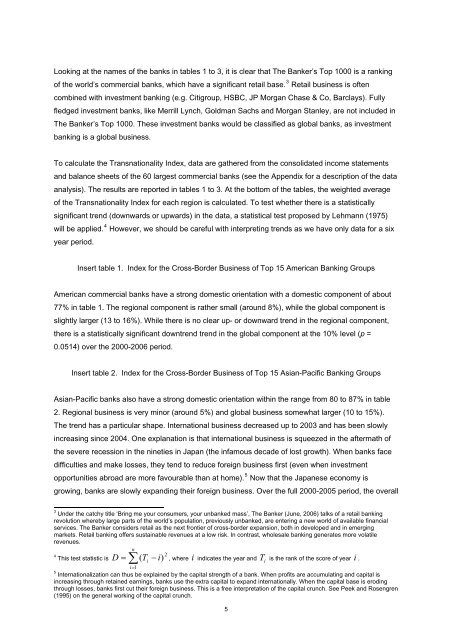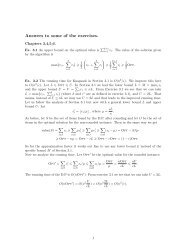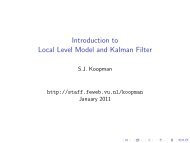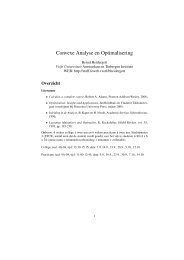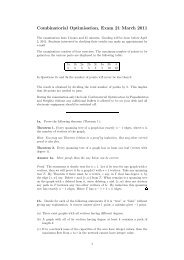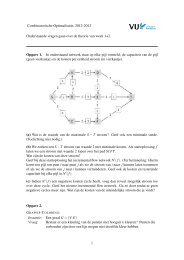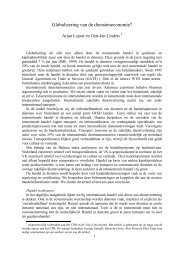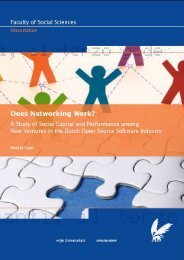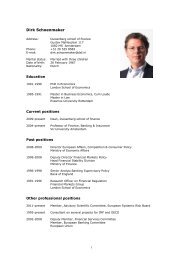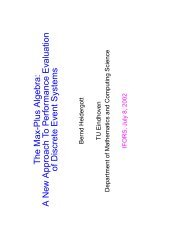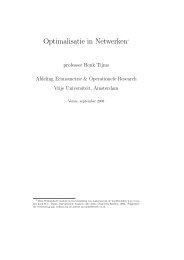Current State of Cross-Border Banking - Vrije Universiteit Amsterdam
Current State of Cross-Border Banking - Vrije Universiteit Amsterdam
Current State of Cross-Border Banking - Vrije Universiteit Amsterdam
Create successful ePaper yourself
Turn your PDF publications into a flip-book with our unique Google optimized e-Paper software.
Looking at the names <strong>of</strong> the banks in tables 1 to 3, it is clear that The Banker’s Top 1000 is a ranking<br />
<strong>of</strong> the world’s commercial banks, which have a significant retail base. 3 Retail business is <strong>of</strong>ten<br />
combined with investment banking (e.g. Citigroup, HSBC, JP Morgan Chase & Co, Barclays). Fully<br />
fledged investment banks, like Merrill Lynch, Goldman Sachs and Morgan Stanley, are not included in<br />
The Banker’s Top 1000. These investment banks would be classified as global banks, as investment<br />
banking is a global business.<br />
To calculate the Transnationality Index, data are gathered from the consolidated income statements<br />
and balance sheets <strong>of</strong> the 60 largest commercial banks (see the Appendix for a description <strong>of</strong> the data<br />
analysis). The results are reported in tables 1 to 3. At the bottom <strong>of</strong> the tables, the weighted average<br />
<strong>of</strong> the Transnationality Index for each region is calculated. To test whether there is a statistically<br />
significant trend (downwards or upwards) in the data, a statistical test proposed by Lehmann (1975)<br />
will be applied. 4 However, we should be careful with interpreting trends as we have only data for a six<br />
year period.<br />
Insert table 1. Index for the <strong>Cross</strong>-<strong>Border</strong> Business <strong>of</strong> Top 15 American <strong>Banking</strong> Groups<br />
American commercial banks have a strong domestic orientation with a domestic component <strong>of</strong> about<br />
77% in table 1. The regional component is rather small (around 8%), while the global component is<br />
slightly larger (13 to 16%). While there is no clear up- or downward trend in the regional component,<br />
there is a statistically significant downtrend trend in the global component at the 10% level (p =<br />
0.0514) over the 2000-2006 period.<br />
Insert table 2. Index for the <strong>Cross</strong>-<strong>Border</strong> Business <strong>of</strong> Top 15 Asian-Pacific <strong>Banking</strong> Groups<br />
Asian-Pacific banks also have a strong domestic orientation within the range from 80 to 87% in table<br />
2. Regional business is very minor (around 5%) and global business somewhat larger (10 to 15%).<br />
The trend has a particular shape. International business decreased up to 2003 and has been slowly<br />
increasing since 2004. One explanation is that international business is squeezed in the aftermath <strong>of</strong><br />
the severe recession in the nineties in Japan (the infamous decade <strong>of</strong> lost growth). When banks face<br />
difficulties and make losses, they tend to reduce foreign business first (even when investment<br />
opportunities abroad are more favourable than at home). 5 Now that the Japanese economy is<br />
growing, banks are slowly expanding their foreign business. Over the full 2000-2005 period, the overall<br />
3<br />
Under the catchy title ‘Bring me your consumers, your unbanked mass’, The Banker (June, 2006) talks <strong>of</strong> a retail banking<br />
revolution whereby large parts <strong>of</strong> the world’s population, previously unbanked, are entering a new world <strong>of</strong> available financial<br />
services. The Banker considers retail as the next frontier <strong>of</strong> cross-border expansion, both in developed and in emerging<br />
markets. Retail banking <strong>of</strong>fers sustainable revenues at a low risk. In contrast, wholesale banking generates more volatile<br />
revenues.<br />
n<br />
4 2<br />
This test statistic is D = ∑ ( Ti<br />
− i)<br />
, where i indicates the year and i is the rank <strong>of</strong> the score <strong>of</strong> year i .<br />
i=<br />
1<br />
T<br />
5<br />
Internationalization can thus be explained by the capital strength <strong>of</strong> a bank. When pr<strong>of</strong>its are accumulating and capital is<br />
increasing through retained earnings, banks use the extra capital to expand internationally. When the capital base is eroding<br />
through losses, banks first cut their foreign business. This is a free interpretation <strong>of</strong> the capital crunch. See Peek and Rosengren<br />
(1995) on the general working <strong>of</strong> the capital crunch.<br />
5


